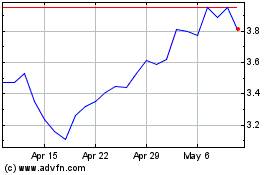IHS Study: Diversity of United States Power Supply Could be Significantly Reduced in Coming Decades
July 24 2014 - 9:00AM
Business Wire
Diversity represents the most cost-effective tool for managing
the fuel cost and technology performance risks of power generation,
study says
Diversity in the U.S. power supply—the most cost-effective means
of managing the inherent risks in fuel costs and technology
performance in generating power—could be dramatically reduced in
coming decades, says a new study by IHS (NYSE: IHS), the leading
global source of critical information and insight. Fuel and
technology decisions on new supply that will determine as much as
one-third of U.S. power supply are required in the coming decades
to meet growth in power demand, replace retiring power plants and
satisfy proposed environmental regulations, the study says.
The new study, The Value of U.S. Power Supply Diversity finds
that a combination of factors—chronically depressed wholesale power
prices, proposed environmental regulations and a focus on
renewables and natural gas over coal, oil, nuclear and
hydroelectric power plants—is currently moving the United States
toward a significant reduction in power supply diversity.
“The critical importance of diversity to stability in power
supplies and prices is the ‘missing factor’ in much discussion on
electricity,” says IHS Energy Vice President and study author,
Lawrence Makovich. “A diversified portfolio of U.S. power supply is
fundamental to a properly functioning electricity system. It the
most cost-effective tool available to manage the inherent risk in
power production costs. However, the value of that diversity is
often taken for granted, which can end up creating major unintended
problems. The ever present potential for price fluctuations,
unforeseen supply shortages and other changes in market dynamics
all make it prudent to not put all of one’s eggs in a single
basket.”
To illustrate the point the study notes that if the U.S. power
sector had been all natural gas-fired since the year 2000, the
average fuel cost for power would have been over twice as high and
month-to-month power bill variation would have been three times
greater.
The study says that incidents during last winter’s polar
vortex—when colder-than-normal weather brought on deliverability
challenges and price volatility for natural gas used to generate
power—demonstrate the value of diversity. Greater demand for
natural gas and electricity to heat homes and businesses in the
U.S. Northeast strained the capability of pipeline systems, which
led to localized price spikes. At some points for brief periods,
additional natural gas was not available at any price.
Oil-fired power generation—although accounting for only 0.35
percent of generation in the Northeast in 2012—provided a critical
alternate supplement to the over-strained natural gas supply system
during the polar vortex, generating power that would have required
delivery of 140 million cubic feet per day of additional natural
gas supplies if gas generation had been the only generating source
available, the study says. In the Midwest, the increased
utilization of coal-fired power plants played a similar role
providing a necessary substitute for constrained natural gas-fired
power plants during the cold snap, the study also notes.
“The critical role that fuel diversity played during the recent
polar vortex affected power systems that serve more than 40 million
U.S. electric consumers and represent nearly one-third of U.S.
power supply,” Makovich added. “The widespread exposure to price
and deliverability risks will become increasingly important as
diversity in U.S. power supply diminishes.”
In coming decades, natural gas’ share of U.S. power generation
could rise to nearly 62 percent; more than double its share in
2013. Previous IHS research has documented the substantial benefits
of the recent boom in U.S. natural gas production—led by the growth
of shale gas—which has dramatically increased U.S. supplies and
energy security while generating significant economic benefits in
terms of jobs, investment and government revenue. However, the
importance of maintaining a level of diversity in the power sector
should also be part of policy and decision-making, the new study
says.
“Engineering and economic analyses consistently show that there
is no single fuel or technology of choice for power generation,”
Makovich added. “Reliably and efficiently supplying consumers with
the amounts of electricity that they need when they need it
requires a diverse fuel and technology mix.”
To illustrate the importance of power supply diversity at the
national level, the new IHS study compared a base case—reflecting
the current generation mix in regional U.S. power systems during
the 2010-2012 period—with a reduced diversity case involving a
generating mix without meaningful contributions from coal and
nuclear power and with a smaller contribution from hydroelectric
power along with an increased share of renewable power. The
remaining three-quarters of generation in the scenario come from
natural gas-fired plants.
In this comparison, IHS found that the cost of generating
electricity in the reduced diversity case was more than $93 billion
higher per year and the potential variability of monthly power
bills was 50 percent higher compared to the base case. As a
consequence, the study calculates that the typical household’s
annual disposable income to be around $2,100 less in the reduced
diversity scenario, there would be around one million fewer jobs
compared to the base case and U.S. gross domestic product (GDP)
would be nearly $200 billion less. The study also says that
additional costs would arise if current trends lead to the
retirement and replacement of existing power plants before it was
economic to do so.
“Current trends in power plant retirements, demand and supply
balances and public policies require the consideration of the value
of power supply diversity in shaping the fuel and technology
choices that will determine the U.S. power generation mix for
decades to come,” Makovich concluded.
About The Report
Download The Value of U.S. Power Supply Diversity at
www.ihs.com/powerdiversity.
The Value of U.S. Power Supply Diversity from IHS utilizes the
company’s extensive knowledge and proprietary IHS Energy models of
the interaction between regional power system demand and supply to
assess the impact on consumers and the U.S. economy of current
trends moving the U.S. power sector toward a significantly less
diverse mix of fuels and technologies for power production. The
energy impacts from wholesale power price changes provide the
inputs into IHS Economics macroeconomic models to generate the
national impacts to U.S. household disposable income, employment,
and GDP growth. This research was supported by the Edison Electric
Institute, the Nuclear Energy Institute and the Institute for 21st
Century Energy at the U.S. Chamber of Commerce.
IHS is exclusively responsible for all of the analysis and
content.
About IHS
(www.ihs.com)
IHS (NYSE: IHS) is the leading source of information, insight
and analytics in critical areas that shape today’s business
landscape. Businesses and governments in more than 165 countries
around the globe rely on the comprehensive content, expert
independent analysis and flexible delivery methods of IHS to make
high-impact decisions and develop strategies with speed and
confidence. IHS has been in business since 1959 and became a
publicly traded company on the New York Stock Exchange in 2005.
Headquartered in Englewood, Colorado, USA, IHS is committed to
sustainable, profitable growth and employs more than 8,000 people
in 31 countries around the world.
IHS is a registered trademark of IHS Inc. All other company and
product names may be trademarks of their respective owners. © 2014
IHS Inc. All rights reserved.
If you prefer not to receive email messages from IHS, please
email press@ihs.com. To read our privacy policy, click here.
IHS Inc.Jeff Marn, +1
202-463-8213Jeff.marn@ihs.comorPress Team+1
303-305-8021press@ihs.com
IHS (NYSE:IHS)
Historical Stock Chart
From Mar 2024 to Apr 2024

IHS (NYSE:IHS)
Historical Stock Chart
From Apr 2023 to Apr 2024
